Today’s Bento, Chicken Patties Bento, uses pre-made dishes that can either be made a day to several days earlier or frozen. Although the main ingredient is pumpkin, crumbed deep-fried croquettes fill your stomach along with the chicken patties. Chicken Patties Bento is colourful and packed with different flavours.

I had to make Chicken Patties Wrapped in Perilla recently because my shiso (perilla) plant had grown so well that I had many shiso leaves to consume. I will post a new recipe using many perilla leaves soon.
What’s in my Chicken Patties Bento
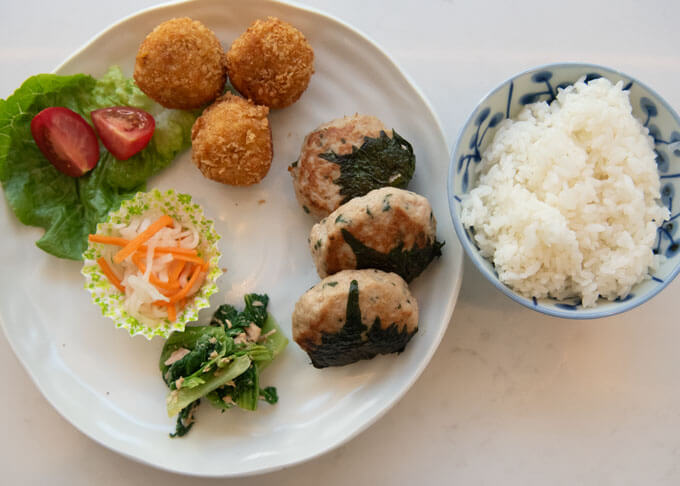
- Cooked rice – you can cook rice ahead. Please refer to How to Cook Rice the Japanese Way. Pack cooked rice in a bento box while rice is still hot or warm as it is easier to shape. Let it cool down before adding other ingredients.
- Chicken Patties Wrapped in Perilla – you can pack either 2 or 3 depending on your appetite and the size of the bento box.
- Pumpkin Croquettes – I picked Pumpkin Croquettes to give a bit more volume to the bento. You can make a day before up to crumbing, then deep-fry on the day. Alternatively freeze the crumbed croquettes and deep-fry frozen or only slightly thaw in microwave and fry. You could also store/freeze deep-fried croquettes, but you need to reheat them before packing in the bento box.
- Pickled Carrot and Daikon Recipe (Kōhaku Namasu) – since both meat dishes are brownish, I thought I should add a bright colour to the dish. The vinegar-based dressing also refreshes your palate.
Other colourful dishes with a sour flavour include Pickled Chrysanthemum Radish and Sweet and Sour Pickled Red Cabbage. - Baby Mustard Greens and Tuna Salad – I thought the green leaves placed next to the red and white pickled dish would look great. The sesame-mayo dressing also adds a new flavour to the bento.
- A piece of lettuce leaf and tomato wedges – I used lettuce to make a partition between the chicken patties and the croquettes. The lettuce and tomatoes also brighten up the bento box.
I added a drop of tonkatsu sauce (not in the photo above) on top of each croquette, but it is optional because the croquettes have sufficient flavours.
Packing Chicken Patties Bento
In my old bento recipes, Bento Box – Chicken Karaage Bento and Bento Box – Hinomaru Bento with Saikyo Yaki Fish, I used a disposable plastic bento box with partitions. But today, I am using an Eco-friendly bento box made from sugarcane pulp.
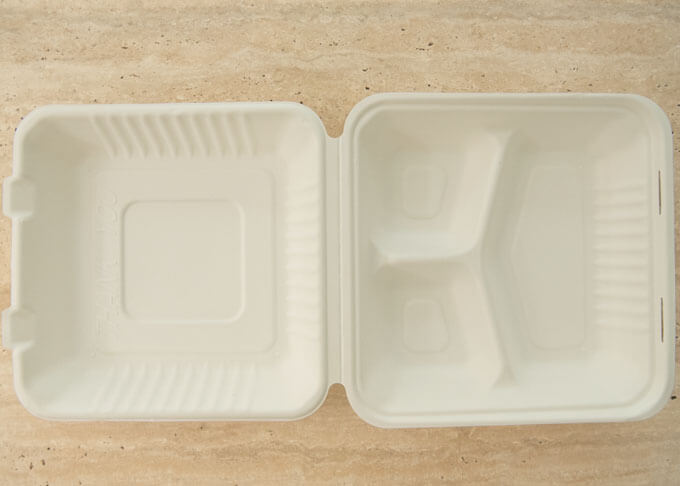
It only has 3 compartments, but that is not a problem as I can use an okazu cup and lettuce to separate the dishes. The photo below is the okazu cup that I used. I bought a pack from Daiso, the discount shop. This cup is great because it brightens up your bento and it’s microwave safe.

One of the 3 partitions is twice as large as the other two equal size partitions. I used the small partition to place 1 serving of cooked rice because it is a perfect size for the rice. I then used the large partition to place the main dishes.

- Place the rice in one of the small partitions.
- Place chicken patties on one side of the large compartment.
- Place a piece of lettuce with tomatoes next to the chicken patties, then place croquettes to fill the compartment.
- Place Kōhaku Namasu in an okazu cup and place it in the small compartment next to the rice.
- Place the baby mustard green salad next to the okazu cup in the same compartment.
- Drop tonkatsu sauce on top of each croquette if using.
A small cos lettuce (romaine lettuce) leaf is perfect here as a divider. I put Kōhaku Namasu in an okazu cup because it has a small amount of liquid, and you don’t want the liquid mixed into the other dish.
If your bento box doesn’t have partitions, you can put the baby mustard green salad in an okazu cup as well.
About Disposable Chopsticks – Waribashi
As the popularity of Japanese food increased, disposable chopsticks became more readily available. They are called ‘waribashi‘ (割り箸) in Japanese.

I used waribashi to eat this bento.
Waribashi was invented in the Yoshino region of Nara prefecture, which is known for the Yoshino cedar tree. It was a byproduct of logging in the 16th century when forestry was thriving for not only building material but also for barrels and tubs. Instead of wasting the wood scraps, they began making chopsticks out of them.
Keeping the end of a pair of chopsticks connected (so you have to break them) came from the characteristics of Yoshino cedar in that it cleanly breaks vertically. You can tell that a pair of chopsticks is brand new as the chopsticks are connected at the end.
Shapes of Waribashi
There are numerous shapes of disposable chopsticks available these days.
Genrokubashi (元禄箸) – Long rectangle chopsticks with grooves made in the middle cracks and the tips shaved into an octagonal shapes. The name came from the name of the gold coin in the Edo period, Genroku koban, which was made with reduced gold due to the shogunate being in financial difficulties. Likewise, genrokubashi is made by shaving here and there to reduce the use of wood. This is the most commonly used waribashi.
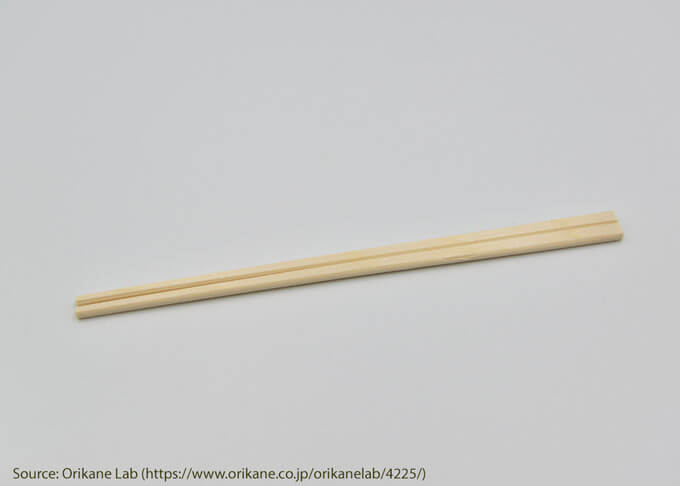
Tensogebashi (天削げ箸) – The handle end (not the tip end) of the chopsticks is shaved diagonally. Tensogebashi is used for hospitality occasions and at high-class restaurants.

Takewaribashi (竹割り箸) – This is made of bamboo, which means that the chopsticks are strong and do not absorb oil. Perhaps because of these characteristics, they are often used in restaurants. There are different shapes of takewaribashi, but the handle end is squarish, and the rest is round with pointed ends, unlike genrokubashi and tensogebashi.

Rikyuubashi (利休箸) – They were invented by the Japanese tea master, Sen no Rikyū. Rikyūbashi are characterised by being thick in the middle and tapering at both ends. They are easy to hold and pick up food, and are also used for hospitality occasions.

Marubashi (丸箸) – Also called Iwaibashi (祝箸). The shape of the chopsticks is similar to rikyūbashi but the sticks are round. The bulge in the middle represents a rice bag, which is interpreted as good luck. One end is said to be used by gods and the other end by humans, signifying that gods and humans eat food together and strengthen the relationship with gods. Marubashi is mainly used at New Year’s celebrations and weddings.

Other shapes – there are more waribashi shapes. Those I used today for the bento are one of them not mentioned above.
Material of Waribashi
Waribashi used to be made mainly from cedar wood in old days. In addition to cedar, cypress, birch, and bamboo are also used for those disposable chopsticks made in Japan. But nowadays, with the exception of high-quality waribashi, disposable chopsticks are imported from overseas countries such as China. This is because raw materials are scarce and Japan-made products are expensive.
The cheapest and most used waribashi material is aspen and birch like in the photo below. Aspen is lightweight, whitish colour, and the wood is soft. It tends to break easily if the chopsticks are not thick enough. Birch is stronger than aspen and it doesn’t break easily. However, it sometimes does not break straight along the connected section due to the direction of the grain.
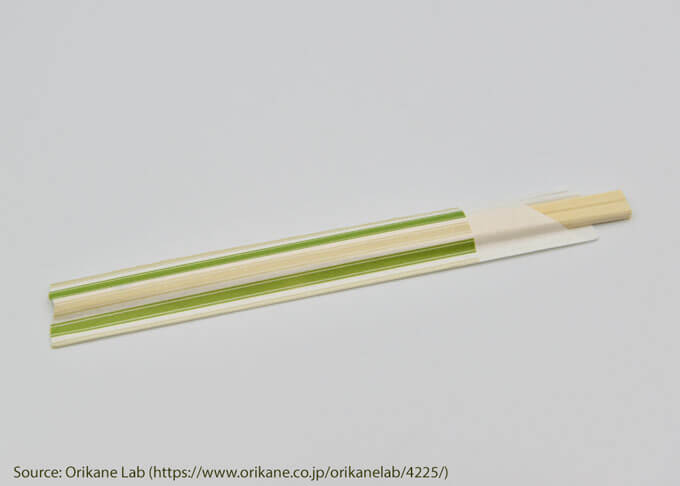
Bamboo is resistant to oil and fire and breaks straight. Bamboo chopsticks (photo below) are often used at tempura restaurants, unagi restaurant, and Chinese restaurant.
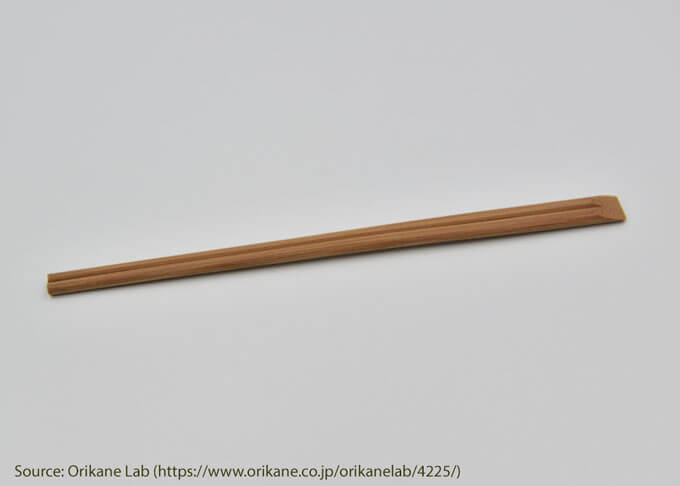
Cedar makes high-quality chopsticks with beautiful straight grains that run vertically. It has excellent characteristics such as clean splitting (due to vertical grains), a woody scent, and moderate strength of the wood. They are expensive and used at high-end restaurants and at home for special occasions. The photo below shows three elegant waribashi made from cedar.
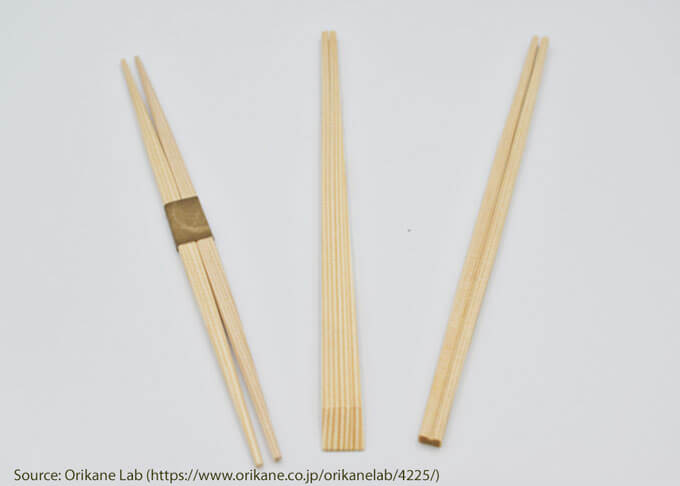
Willow chopsticks are used for celebrations because willow is strong, flexible, and does not break easily. Iwaibashi is the typical chopsticks made from the willow tree. Because they are used in celebratory occasions, the chopsticks are not connected at one end to avoid the ‘breaking’ action, which is considered bad luck.
A pair of iwaibashi are placed in a chopsticks case that is made of red and white paper representing good luck.
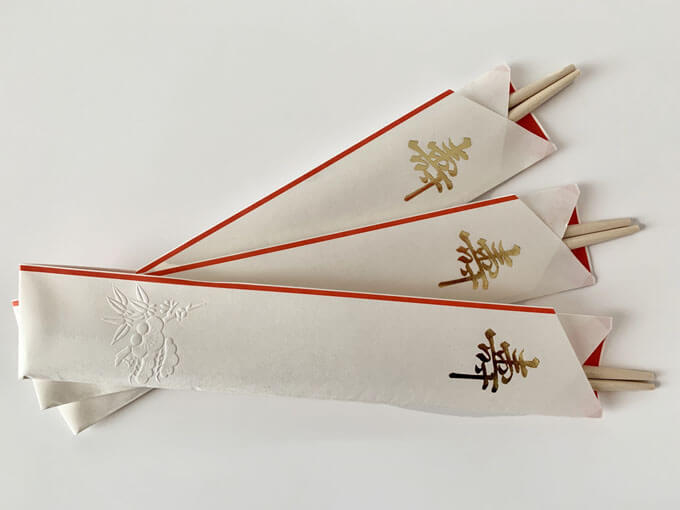
Yumiko![]()
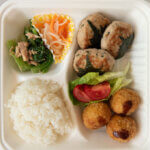
Chicken Patties Bento includes two dishes that can fill up your stomach - Chicken Patties Wrapped in Perilla and Pumpkin Croquettes. With two vegetable side dishes, it becomes a colourful bento packed with different flavours.
You can adjust the number of chicken patties and croquettes to suit to your appetite.
Because bento is usually made mostly from left-over dishes or make-ahead dishes, the time indicated in this recipe only shows the time to pack the bento box and the minimum cooking time that is required before packing.
- 1 cup cooked rice (note 1)
- 3 Chicken Patties Wrapped in Perilla
- 3 Pumpkin Croquettes
- 30g/1.1oz Pickled Carrot and Daikon Recipe (Kōhaku Namasu)
- 50g / 1.8oz Baby Mustard Greens and Tuna Salad
- 1 cos lettuce (romaine lettuce) leaf (or other lettuce leaves)
- ½ baby tomato halved into wedges
- 1 Eco friendly bento box with partitions (note 2)
-
Put the rice in the second largest compartment.
-
Place chicken patties in a largest compartment, filling half the space. Then place the lettuce and tomato wedges next to them.
-
Put the pumpkin croquettes next to the lettuce to fill the compartment. Drop the tonkatsu sauce on top of each croquet, if using.
-
Place the Kōhaku Namasu in an okazu cup and place it in the small compartment next to the rice
-
Place the mustard greens salad in the same compartment as the Kōhaku Namasu (you may need to push the cup to squeeze the salad in).
1. It is best to pack the cooked rice in a bento box while hot or warm as it is easier to shape the rice into the bento box.
2. If you don't have a bento box with partitions, you can still pack bento using okazu cups to separate the dishes.
I enjoyed your mini-tutorial on waribashi. We here in the United States have been told that bamboo waribashi are the most ecologically responsible and have been encouraged to try to get restaurants to provide that type.
Hi Lynne, it is true because bamboos grow so fast.
Love it❤️
Thanks for this, it’s a yummy balance of flavours and I love the make ahead tips!
I like a bento with varieties of flavours and colours too!